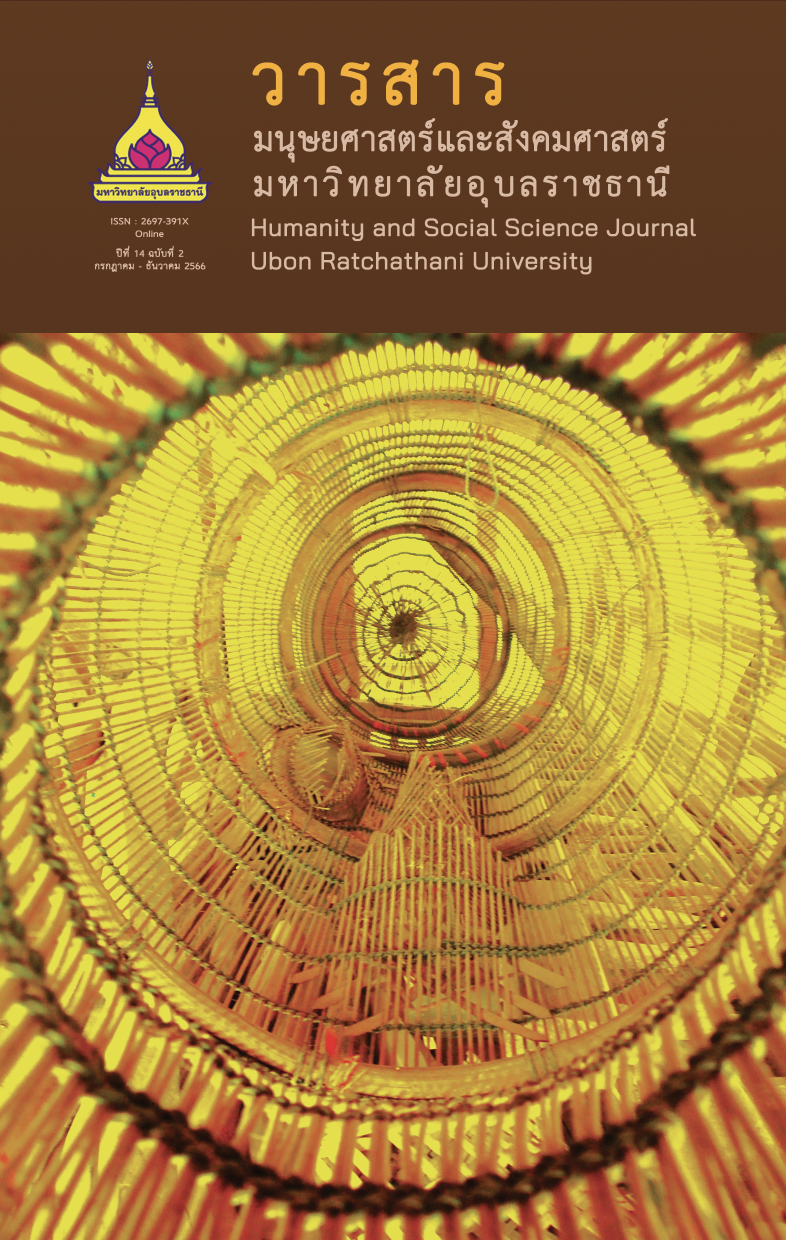แนวทางการสร้างเสริมเด็กสองภาษา (ไทย – อังกฤษ)
Main Article Content
บทคัดย่อ
ยิ่งเด็กเรียนรู้ภาษาที่สองเร็วเท่าไร ยิ่งดีมีประสิทธิภาพ โดยอาศัยความมุ่งมั่นตั้งใจของพ่อแม่ที่ต้องการสร้างเสริมลูกให้เป็นเด็กสองภาษา ในคำจำกัดความนี้ ภาษาที่กล่าวถึงคือ ภาษาอังกฤษที่เป็นภาษาสากล ตามหลักการแล้ว มีนักทฤษฎีและนักภาษาศาสตร์หลายท่าน กล่าวเป็นเสียงเดียวกันว่า ในช่วงวัยเด็กเป็นเวลาแห่งการเรียนรู้ภาษาได้ดีที่สุด ผู้เขียนจึงมีวัตถุประสงค์เพื่อนำเสนอทางเลือก และวิธีการสอนเด็กสองภาษา สำหรับพ่อแม่ และสำหรับครูผู้สอนในโรงเรียนที่ช่วยสร้างเสริมให้เด็กเรียนรู้ภาษาที่สองอย่างมีประสิทธิภาพควบคู่กับภาษาแม่ สำหรับในครอบครัว พ่อแม่จำเป็นต้องเตรียมความพร้อม และฝึกฝนการใช้ภาษาที่สองของตนเอง เพื่อเป็นต้นแบบที่ดีให้ลูก พ่อแม่สามารถเลือกการสอนที่เหมาะสมต่อบริบทของครอบครัว ประกอบด้วย 5 ทางเลือก ได้แก่ 1) หนึ่งคนหนึ่งภาษา 2) การเลือกเวลาตามสะดวก 3) หนึ่งภาษาในบ้าน หนึ่งภาษาในสังคม 4) การใช้ภาษาที่หลากหลายในบ้าน และ 5) การส่งเสริมการเรียนโดยเจ้าของภาษา อีกทั้งการส่งเสริมเด็กในโรงเรียนนั้น ครูผู้สอนเป็นอีกหนึ่งกำลังสำคัญในการสร้างเสริมเด็กสองภาษา โดยเริ่มได้ตั้งแต่ระดับปฐมวัย ครูผู้สอนต้องเลือกวิธีการสอนภาษาให้เหมาะสมต่อบริบทของเด็กไทยในศตวรรษที่ 21 โดยเน้นทักษะด้านการสื่อสารเป็นสำคัญ เน้นการฟัง และการพูดในชีวิตประจำวัน ควบคู่กับการส่งเสริมด้านการอ่านและการเขียนตามลำดับ อีกทั้งควรเน้นการจัดการเรียนรู้และการจัดการชั้นเรียนแบบเชิงรุก ซึ่งบทบาทของครูผู้สอนจะน้อยลง แต่กลายเป็นผู้วางแผน ผู้อำนวยความสะดวก และเป็นที่ปรึกษา เพื่อคอยกระตุ้น และส่งเสริมให้เด็กเรียนรู้ด้วยตนเอง ฉะนั้นถึงเวลาแล้ว ทั้งพ่อแม่ และครูผู้สอน ต้องตระหนักถึงความสำคัญ และวางแผนการเรียนรู้ภาษาที่สองของเด็กโดยเร็ว
Article Details

อนุญาตภายใต้เงื่อนไข Creative Commons Attribution-NonCommercial-NoDerivatives 4.0 International License.
บทความที่ได้รับการตีพิมพ์เป็นลิขสิทธิ์ของวารสารมนุษยศาสตร์และสังคมศาสตร์ มหาวิทยาลัยอุบลราชธานี
ข้อความที่ปรากฏในบทความแต่ละเรื่องในวารสารวิชาการเล่มนี้เป็นความคิดเห็นส่วนตัวของผู้เขียนแต่ละท่านไม่เกี่ยวข้องกับมหาวิทยาลัยอุบลราชธานี และคณาจารย์ท่านอื่นๆในมหาวิทยาลัยฯ แต่อย่างใด ความรับผิดชอบองค์ประกอบทั้งหมดของบทความแต่ละเรื่องเป็นของผู้เขียนแต่ละท่าน หากมีความผิดพลาดใดๆ ผู้เขียนแต่ละท่านจะรับผิดชอบบทความของตนเองแต่ผู้เดียว
เอกสารอ้างอิง
Amo, M. D. B. (2015). An approach to bilingualism: theoretical background applied to a personal experience. Spain: Valladolid University, 23.
Brisk, M. E. & Proctor, C. P. (2019). Challenges and supports for english language learners in bilingual programs. United State: Understanding Language Stanford University School of Education, 1–8.
Choomchaiyoo, N. (2012, Nov 1). Talk with Kru Ket. I get English, 6(44), 96-98. (in Thai)
Corvalán, C. S. (2014). Bilingual Language Acquisition. United Kingdom: Cambridge University Press, 65-67.
Forslund, K. (2009). Aspects of bilingualism. [Essay]. Sweden: Halmstad Univesity, 6 – 10. https://www.diva-portal.org › get › fulltext01
Heather. (2018, August 17). Tips for Raising Bilingual Kids |Superholly. [Video file]. https://www.youtube. com/watch?v=DTTNhoK_3gA
Heinlein, B., Williams, L. (2013). Bilingualism in the Early Years: What the Science Says. Learn Landsc, 7(1), 1-15.
Ibuka, M. (2019). It’s Too Late After Kindergarten. (Sumit, T & Niyomka, P.). Bangkok: Praew Puen Dek. (Original Manuscript 2004 AD), 1-3.
Kamalanavin, V. (2015). Raising Thai-English bilingual children in a native thai Family: Worth a Try or Waste of Time. Pasaa Paritat Journal. (30), 256-265.
Lai, W. & Wei, L. (2019). A Critical Evaluation of Krashen’s Monitor Model. Theory and Practice in Language Studies, 9(11), 1459-1464.
Lalimay. (2019). Being Bilingual Child easily by talking with Mom Cherry. https://www.parentsone.com/ interview -for-two-languages-kids/. (in Thai)
Nemeş, A. & Moraru, A. (2013). Language Development in Bilingual Children – Comparative Preschool Age Study. Academica Science Journal, 1(3), 18-24. https: //www. researchgate. net/publication/288829887_LANGUAGE_DEVELOPMENT_IN_BILINGUAL_CHILDREN_COMPARATIVE_PRESCHOOL_AGE_STUDY
Pokaisawan, C., Kuea-sanoh, I. & Sutthiphong, R. (2018) Human Acquisition Language with Brain. The 6th National Academic Conference: Advanced Agriculture and Sustainable Thai Society (1398 – 1406). Ratchaburi: Muban Chombueng Rajabhat University.
Pransiska, R. (2017). Benefits of Bilingualism in Early Childhood: A Booster of Teaching English to Young Learners. Advances in Social Science, Education and Humanities Research, (58), 390 – 393.
Richards, J. C. & Rodgers, T. S. (2001). Approaches and Methods in Language Teaching (2nd ed.). New York: Cambridge University Press, 153-162.
Ritchie, W. C. & Bhatia, T. K. (1996). Handbook of Second Language Acquisition. United Kingdom. Academic Press, 454.
Sangsin, N. (2000). English Learning and Teaching for Second Language or Foreign Language. Chiangmai, University: n.p., 76-86. (in Thai)
Saxton, M. (2017). Child Language Acquisition and Development (2nd ed.). United Kingdom: SAGE Publications.
Sekkhontod, S. N. T. (2014). Genius Bilingual Family. Bangkok: Proud Poet, 45.
Sukhphan. (2018). The Development of English Communication Skills as Graduate in Modern Times. MCU Haripunchai Review, 2(2), 89-100. (in Thai)
Techapahapong, P. (2009). Dek Song Pasa Po Mae Sang Dai [bilingual children: Parents Could Raise]. Bangkok: Mind connections, 78-82. (in Thai)
Techsauce (2022). Growth Mindset. https://techsauce. co/saucy-thoughts/thai-uk-alumni-and-professional-network-. (in Thai)
Thornbury, S. (2002). How to teach Vocabulary. England: Pearson Education, 13, 112-115.
Wongyai, W. & Patphol, M. (2019). Development of Innovation Skills. Innovation Leadership Center in Curriculum & Learning (LCCL), 6.
Wright, C. J. H. (2017). Chris Jobs: How to pronounce Thai accent correctly? [Facebook Page]. https://www.facebook.com/ watch/?v=695894308480009 (in Thai)


